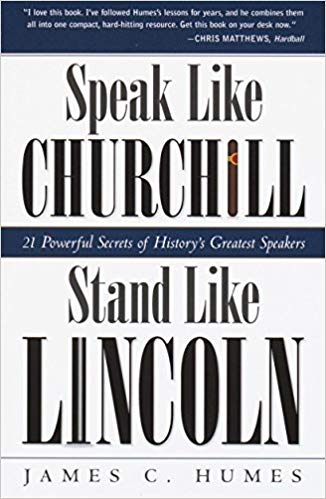 Before writing each week’s executive book summary I ask, “What have I read that would be the most valuable and practical help for Bible teachers, pastors, and ministers?” The answer this week comes from an unlikely source, James C. Humes, a former speechwriter for Presidents Eisenhower, Nixon, Ford, and Reagan. Humes’ book, “Speak Like Churchill, Stand Like Lincoln: 21 Powerful Secrets of History’s Greatest Speakers,” ($11.95 for the Kindle edition on Amazon) is a rich and expert volume about how to deliver a great speech, talk, or sermon.
Before writing each week’s executive book summary I ask, “What have I read that would be the most valuable and practical help for Bible teachers, pastors, and ministers?” The answer this week comes from an unlikely source, James C. Humes, a former speechwriter for Presidents Eisenhower, Nixon, Ford, and Reagan. Humes’ book, “Speak Like Churchill, Stand Like Lincoln: 21 Powerful Secrets of History’s Greatest Speakers,” ($11.95 for the Kindle edition on Amazon) is a rich and expert volume about how to deliver a great speech, talk, or sermon.
Don’t Sabotage Your Sermons With Poor Delivery:
Far too many sermons with powerful biblical truth and life-changing content have been sabotaged by bad delivery and poor communication. Sadly, this includes way too many of my own sermons. We must never make the Good News of the Greatest Story Ever Told disengaging, boring, or hard to listen to. Therefore, learning about public speaking from people like Winston Churchill (He turned his words into weapons and scared the Nazis), Ronald Reagan (the Great Communicator), and Abraham Lincoln is a rare and valuable resource with vital information and expert coaching for every teacher and preacher.
The “Power Reading” Technique For Notes Or Manuscript:
Humes’ book devotes each of the book’s 21 chapters to a different “secret” for powerful communication. However, rather than dilute today’s post by offering too much advice, I want to follow the “less is more” philosophy and unpack just one of the book’s most important public speaking principles. It has to do with what Humes calls “Power Reading,” a highly effective way to use written sermon notes or even a full manuscript and still be a powerful and engaging communicator. Homes says “Power Reading” is “the art of reading a speech while appearing not to.” According to Humes, great communicators like Winston Churchill, Franklin Roosevelt, and Ronald Reagan all used this powerful technique. Here are a few key points:
- Don’t Speak While Looking Down. “The first rule of effective speaking is . . . Never, never, never let words come out of your mouth when your eyes are down. . . . when you are looking down and speaking, you are disconnecting the current of your words to your listeners. You must be looking at your listeners when you are talking to them.”
- Use The See-Stop-Say Technique. “Look down and take an imaginary ‘snapshot’ of the words you see. Bring your head back up and pause. Then . . . say, or ‘conversationalize’ what you have just memorized. Then look down again to see the next chunk of words, bring your head back up, pause, and then speak. See, Stop, Say.”
- Pauses Are What Make a Speech (Or Sermon) Sound Conversational. Those unused to such an approach may feel awkward and fear the pauses will cause them to lose the listener. “Wrong! Sure, the pause does let you read the speech (or sermon notes) in segments while still fixing your eyes on the audience. But the real power of the pause is that it gives your listeners time to digest what you’re saying . . . the pause is your most powerful tool in speaking.”
- Not Awkward But Authentic. “When you read a speech without pauses, you seem to be reading a speech someone else wrote for you. When you pause, you sound sincere, as if you’re trying to come up with the right words to express your thoughts.”
You Never Find Great Communicators With Their Heads Down And Stuck In Their Sermon Notes:
You probably know that some of the very best preachers work long and hard to find and unpack great biblical content. However, you may be surprised to learn that many of these great preachers also write complete manuscripts of their messages. On the other hand, you’ll never find these great communicators with their heads down and stuck in their sermon notes. The very best communicators have mastered preaching in a conversational way so the listener feels that the preacher is talking right to them rather than merely “reading” a sermon. I highly recommend Humes’ book. In my opinion, Chapter 12 – Power Reading alone is worth the price of the book.
